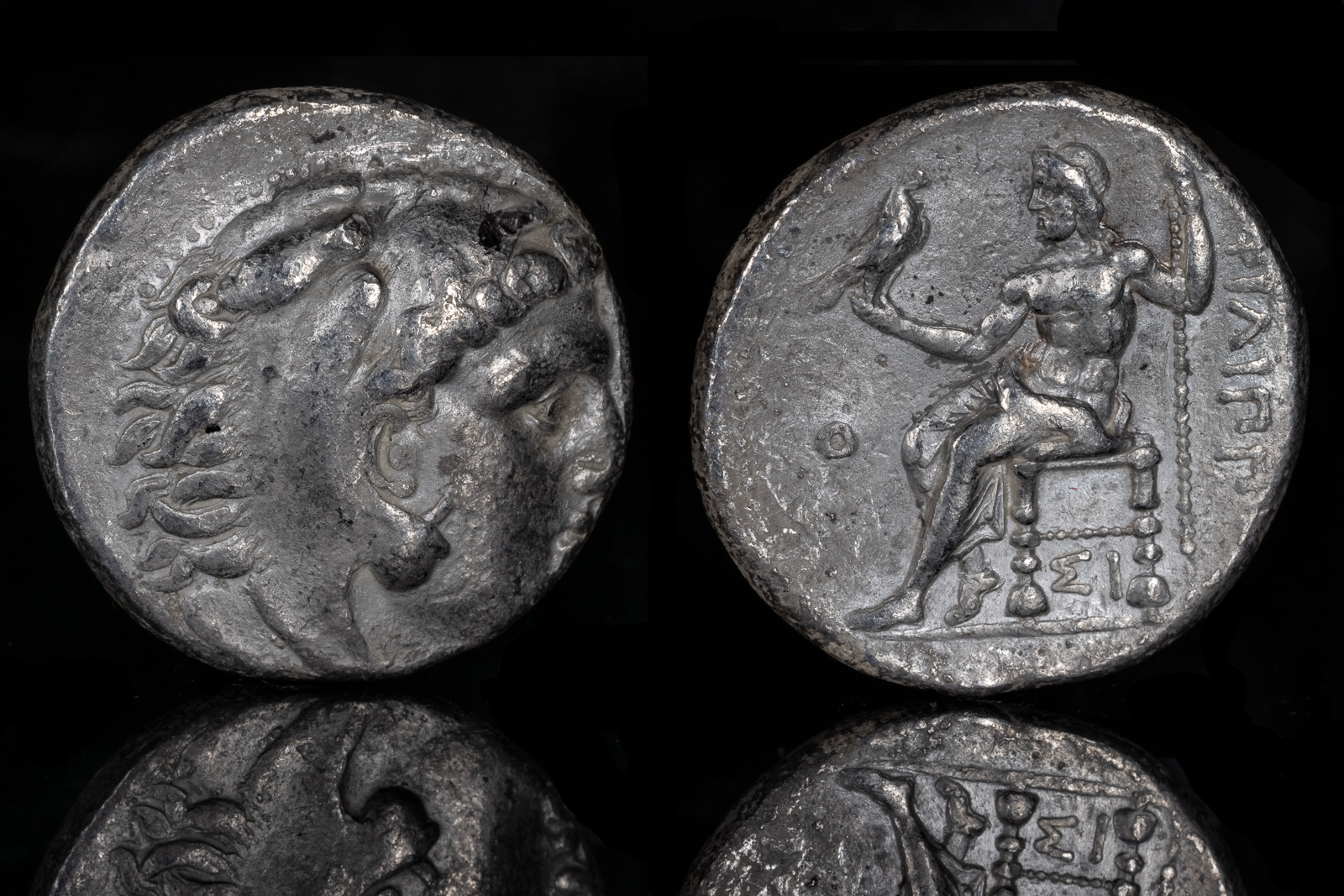
Philip III Arrhidaios
AR Tetradrachm 319/318 BCE
16.95g, 26mm, 12h
Struck under Laomedon, in the types of Alexander III. Sidon, dated RY 15 of Abdalonymos = 319/8 BC. Head of Herakles to right, wearing lion skin headdress / Zeus Aëtophoros seated to left, holding sceptre; ΦΙΛΙΠΠΟΥ to right, O (date) in left field, ΣI below throne.
Price P175; Newell, Dated 45; DCA 878
Sidon is likely among the oldest continuously inhabited cities on the planet. Even by the time Alexander the Great arrived and the city was surrendered to him without a fight, it had a long and rich history. It was among the most important of the Phoenician cities and was mentioned in ancient Egyptian texts.
A number of different civilizations possessed Sidon, and it was generally the city’s (and Phoenicians’) strategy to bow to whatever empire came along while retaining the right to trade. Before Alexander, the Egyptians, Babylonians, and Persians all controlled the city.
Besides trade, Sidon made a good income from the production of glass.
When Alexander took over, the people of Sidon asked him to choose a king. He chose Abdalonymos, who was related to the Sidon monarchy but had chosen the quiet life of a gardener.
After Alexander the Great’s death, Sidon was first claimed by Perdikkas and then taken by Ptolemy. It remained under Lagid control until Roman times.

Phoenicia, Sidon AR 1/16 Shekel
`Abd`aštart (Straton) I
dated RY 6 = 337/6 BCE 0.86g, 9mm, 12h.
Phoenician galley to left; IIIIII above, waves below / Persian king or hero, holding dagger and standing to right, fighting lion standing to left; [‘B] (in Phoenician) between; all within incuse square.
E&E-S Group IV.5.4.c; DCA 866; HGC 10, 263
Ex Gorny & Mosch Giessener Münzhandlung 2012
Ex Roma 2021

Samaria ‘Middle Levantine’ Series. Circa 375-333 BCE
AR Obol 9.7mm 0.65g
Phoenician galley left (‘b’ in Phoenician) above, waves below.
R: Persian king or hero, holding dagger in his right hand, standing right, grasping lion standing right, head to left, at mane; in field, O; all within incuse square.
Meshorer & Qedar 199
Ex Ars Coin Wien
Sidon is part of the Egyptian empire and is ruled by Zimredda.
King Abdi-Milkutti of Sidon rises up against the Assyrians.
Sidon is taken by the Assyrians after a siege, Abdi-Milkutti is decapitated and some of Sidon’s treasure is taken to Tyre.
Eshmunazar I founds a dynasty in Sidon.
Death of Eshmunazar I of Sidon. Tabnit I becomes king.
Death of Tabnit I, whose sarcophagus was found with his body perfectly intact in 1887. Eshmunazar II becomes King of Sidon.
Premature death of Eshmunazar II, whose sarcophagus today is displayed in the Louvre. His son Bodashtart becomes King of Sidon.
Death of Bodashtart of Sidon. He had restored the Temple of Eshmun. His heir Yatonmilk becomes king.
Death of Yatonmilk of Sidon. Anysos becomes king.
September 26
Aegina plays a significant role in the Greek naval victory against the Persian Empire in the Battle of Salamis. Byblos, Arados, Tyre, Halikarnassos under Artemisia, Kos, and Sidon support Darius. Chalkis and Kythnos support the Greek effort. Alexander I serves as a peace negotiator on behalf of the Persians.
Sidon rises in rebellion against Persian rule under Artaxerxes II. The rebellion is initially successful, but Artaxerxes III eventually suppresses it after Sidon is besieged and captured. The city’s destruction and subsequent punishment mark a decline in Sidon’s prominence.
Approximate date of the founding of Caesaria Maritima by Straton I of Sidon. The original name is Straton’s Tower.
Another major rebellion erupts in Sidon against Persian control, led by Tennes (Tabnit), the king of Sidon, who initially receives support from Egypt and Cyprus. However, Artaxerxes III besieges Sidon and defeats the rebels. The Persians destroy Sidon in retaliation, leading to a massacre where thousands of Sidonians die.
Artaxerxes III Okhos sends his satraps Belesys and Mazaios to retake Sidon, Tyre, and Byblos. The Persians are defeated by the Phoenicians, supported by Nektanebo II and Mentor of Rhodes.
Sidon, Byblos, and Arados under Gerostratos submit to Alexander the Great as he travels through Phoenicia.
Alexander III deposes Straton as king of Sidon.
Sidon shelters many Jews during the revolts and saves them from being killed.